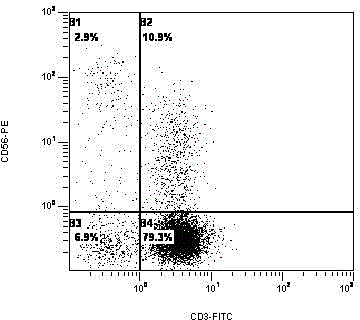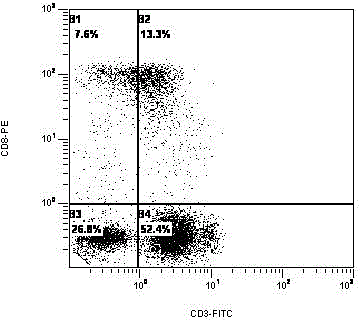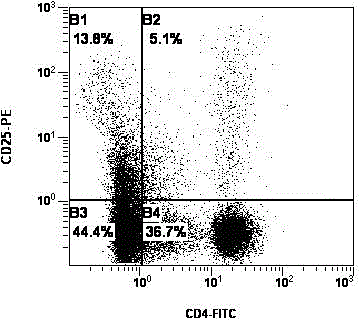Method for culturing autologous peripheral blood lymphocyte
A technology of lymphocytes and culture methods, applied in the field of CIK culture of autologous peripheral blood lymphocytes, which can solve the problems of increased expression and does not take into account the effect of T regulatory cell content on tumor immune escape, so as to achieve the effect of improving killing activity
- Summary
- Abstract
- Description
- Claims
- Application Information
AI Technical Summary
Problems solved by technology
Method used
Image
Examples
Embodiment 1
[0074] Example 1 A method for extracting peripheral blood mononuclear cells
[0075] A method for extracting peripheral blood mononuclear cells, comprising the steps of:
[0076] (1) Collect 30-100mL of peripheral blood with a sodium citrate anticoagulant tube, transfer the peripheral blood to a 50mL centrifuge tube, centrifuge at 2000rmp for 15min;
[0077] (2) Discard the upper layer of plasma, dilute the blood cells with normal saline so that the ratio of blood cells: normal saline is 1:1, and mix well;
[0078] (3) Pipette 15mL of Ficoll lymphocyte separation solution into a 50mL centrifuge tube, and add the mixed cell suspension evenly and slowly to the upper layer to form a complete interface;
[0079] (4) 1600rpm, centrifuge for 20min, obvious stratification can be seen;
[0080] (5) Collect interface mononuclear cells and wash them twice with PBS;
[0081] (6) Resuspend the cells in PBS and count them for later use.
Embodiment 2
[0082] Example 2 A method for cultivating CIK cells
[0083] A method for cultivating CIK cells, comprising the steps of:
[0084] (1) Use X-VIVO15 serum-free medium to adjust the cell concentration of the mononuclear cells isolated in Example 1 to 1*10 6 pcs / mL, placed at 37°C, 7.5%CO 2 incubator cultivation;
[0085] (2) On the third day, add X-VIVO15 serum-free medium to 100mL, and add 1000U / mL IL-2;
[0086] (3) On the fourth day, add X-VIVO15 serum-free medium to 240mL, and add IL-2 to keep the concentration unchanged;
[0087] (4) On the seventh day, put the cell suspension into a 1.8L culture bag, add X-VIVO serum-free medium to 1000mL, add IL-2 to keep its concentration at 1000U / mL, and add CTLA-4mAb 100ng / mL at the same time mL, PD-1mAb 100ng / mL;
[0088] (5) On the 14th day, the cultured CIK cells were collected by centrifugation and washed twice with 0.9wt% sodium chloride solution. Dilute sodium chloride solution to 100mL.
Embodiment 3
[0089] Example 3 Detection of immunophenotype of CIK cells
[0090] The immunophenotype detection of CIK cells includes the following steps:
[0091] (1) Take the cells on the 1st, 7th, and 14th day of culture respectively, transfer them into the flow detection tube, add 3mL PBS to mix well, and centrifuge to wash the cells (centrifugation condition: 1600rpm, 5min). Pour off the centrifuged supernatant, according to the concentration and volume of the cell sample, suspend the cells with an appropriate amount of PBS, and adjust the cell concentration to 1x10 5 a / ml;
[0092] (2) Fluorescence-labeled cells: label flow detection tubes, label 4 tubes for each sample, tube 1: IgG-FITC / IgG-PE, tube 2: CD3-FITC / CD56-PE, tube 3: CD3-FITC / CD8-PE, tube 4: CD4-FITC / CD25-PE, add the corresponding fluorescent antibody to each tube, the volume of each antibody is 8 μL, add 100ul of the cell sample suspension to be tested in each tube;
[0093] (3) Gently rotate and mix on a vortex shake...
PUM
 Login to View More
Login to View More Abstract
Description
Claims
Application Information
 Login to View More
Login to View More - R&D Engineer
- R&D Manager
- IP Professional
- Industry Leading Data Capabilities
- Powerful AI technology
- Patent DNA Extraction
Browse by: Latest US Patents, China's latest patents, Technical Efficacy Thesaurus, Application Domain, Technology Topic, Popular Technical Reports.
© 2024 PatSnap. All rights reserved.Legal|Privacy policy|Modern Slavery Act Transparency Statement|Sitemap|About US| Contact US: help@patsnap.com










